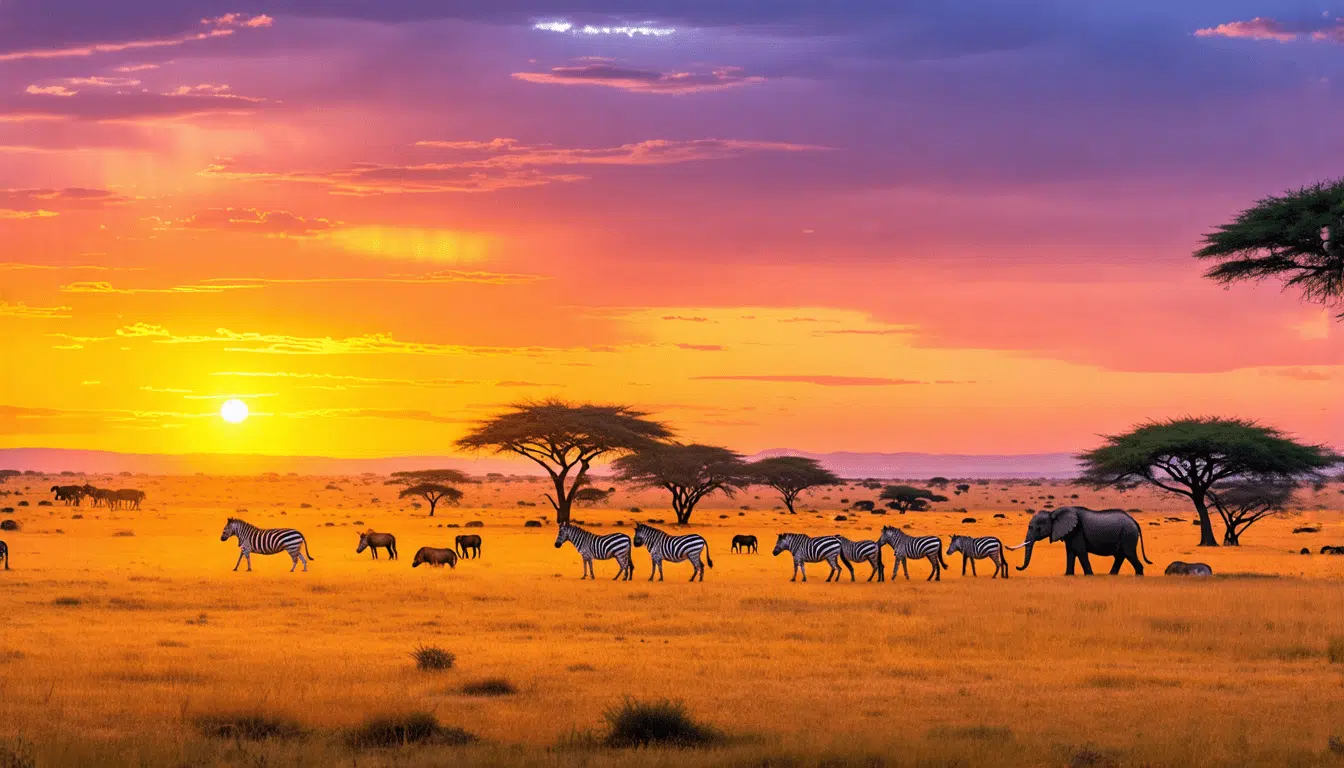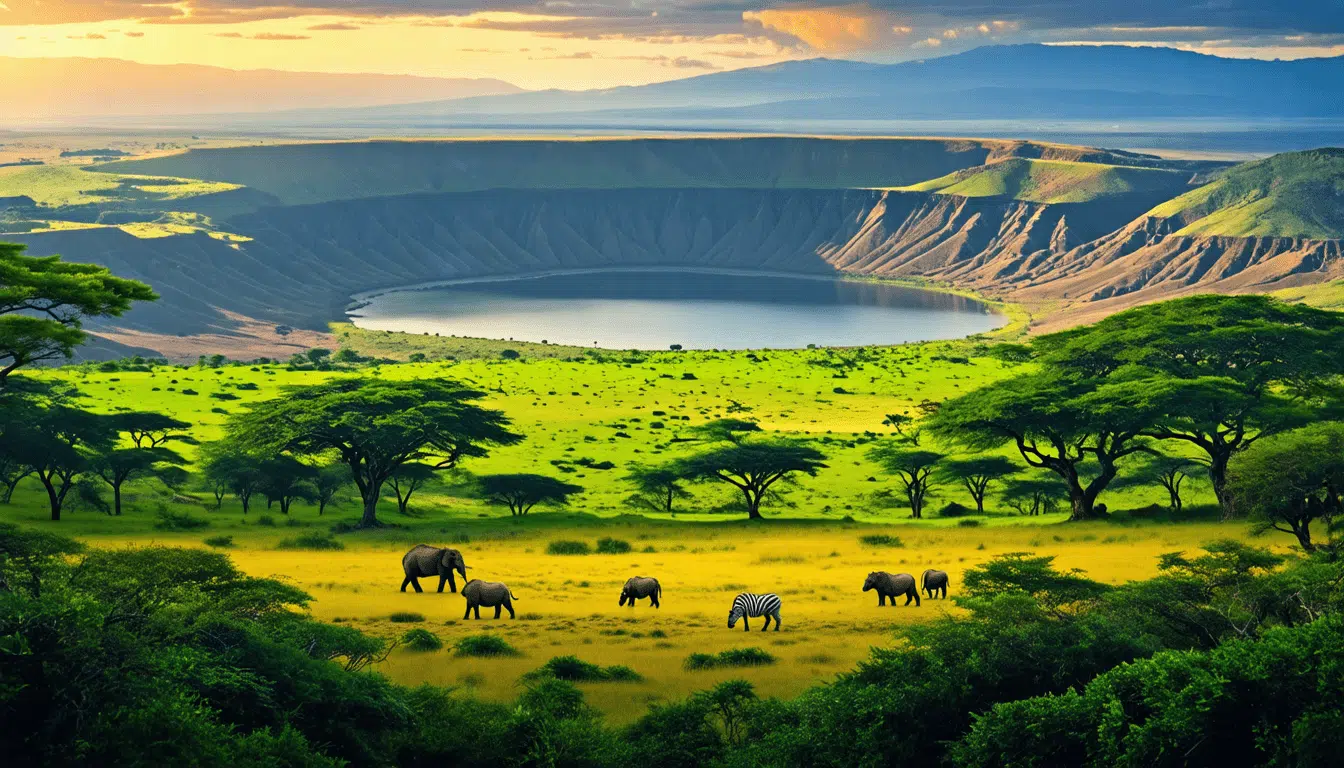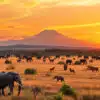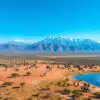Introduction to Tanzania’s Best Safari Parks
Imagine this: the African sun rising over a horizon dotted with acacia trees, the distant roar of a lion greeting the dawn, and herds of wildebeests and zebras moving with purpose across the plains. Sounds like something out of a dream, right? Well, that’s Tanzania for you. This East African gem is not just a country; it’s a cornerstone of some of the world’s most stunning wildlife and untouched natural beauty. Whether you’re a first-time safari-goer or a seasoned adventurer, Tanzania’s safari parks offer an experience you won’t want to miss.
Why is Tanzania so special for safaris, you ask? For starters, it’s home to some of the most iconic safari parks on the continent. These parks are not just vast stretches of wilderness; they’re living, breathing ecosystems teeming with life. Wildlife enthusiasts and nature lovers will tell you: there’s something almost magical about witnessing African wildlife up close in their natural habitat.
So, are you ready to dive into the wild world of Tanzania’s top safari destinations? Trust me, you’re in for a treat. But before we get to the stars of the show, let’s set the stage. Here are the top Tanzania safari parks that you absolutely shouldn’t miss.
Introduction to Tanzania’s Best Safari Parks
Imagine a place where the horizon stretches out forever, where wild animals roam freely in their natural habitat, and where every sunrise and sunset leaves you in awe. Welcome to Tanzania, undeniably one of the top safari destinations in the world. Why, you ask? Let’s dive into it!
First off, if you’re a wildlife enthusiast or a nature lover, Tanzania’s safari parks are your dream come true. The diversity of African wildlife here is mind-blowing. We’re talking about seeing lions, leopards, elephants, rhinos, and buffaloes all in one trip. Yup, the Big Five! And that’s not even scratching the surface.
Tanzania’s safaris are more than just a sightseeing tour; they are an opportunity to immerse yourself in the wild, understand ecosystems, and see the intricate dance of survival and harmony in nature. Whether you’re a seasoned traveler or someone just stepping into the world of safaris, Tanzania offers an experience that’s truly unforgettable.
In this article, we will explore a few of the best safari parks you absolutely shouldn’t miss when visiting Tanzania. Buckle up, because this journey through the heart of African wildlife is about to get thrilling!
Why Are Tanzania’s Safari Parks Top Safari Destinations?
You might be wondering, what makes Tanzania so special? For starters, Tanzania is home to some of the most famous and biodiverse parks in all of Africa. Each park offers something unique, ensuring no two safari experiences are ever the same.
Take for example the iconic Serengeti National Park, known for its endless plains and the dramatic Great Migration. Or the stunning Ngorongoro Crater, a natural wonder teeming with wildlife where you can find practically every animal that calls East Africa home. Every park has its character and charm, making Tanzania an unbeatable safari destination.
The Importance of Safaris for Wildlife Enthusiasts and Nature Lovers
Ever watched a nature documentary and found yourself riveted by the astounding behaviors of wild animals? That’s the magic a safari brings to life. Safaris allow you to witness these moments in real-time, right before your eyes. For wildlife enthusiasts, it’s a front-row seat to nature’s untamed theatre.
Let me share a quick story. I remember my first safari in Tanzania. We were in the Serengeti, just as dawn was breaking. Our guide pointed to a pride of lions, lazily stretching and yawning. Moments later, we spotted a solitary cheetah, gracefully stalking its prey. It was an emotional moment that I will never forget, and I realized right then why these experiences are so profound.
For nature lovers, Tanzania’s landscape offers a diverse canvas of beauty. From savannahs to woodlands, and calderas to lakes, the scenery alone is worth the trip. And the best part? Every season brings a different phase of life, ensuring your visit is always unique and compelling.
Now that you’re acquainted with the magic of Tanzania’s safari parks, it’s time to delve deeper into some of the must-visit parks. Trust me, you won’t want to miss what’s coming next!
Serengeti National Park: The Iconic Savannah
Ah, Serengeti National Park! Just the name conjures up images of vast, golden plains dotted with wildebeest, zebras, and breathtaking sunsets that would make any painter envious. If you’re anything like me and a total wildlife buff, this is your paradise on Earth. Picture this: miles and miles of undulating plains, where you can witness the greatest wildlife spectacle known to humanity—the Great Migration. It’s the perfect setting for those classic safari moments we all dream of.
The Serengeti’s Wildlife and Ecosystem
The Serengeti is the textbook definition of an African safari. With its rich and diverse ecosystem, it’s home to an impressive array of wildlife. From the stealthy cheetah prowling the open savanna to the towering giraffes elegantly stretching their necks to munch on treetops, the Serengeti offers a bit of everything. And let’s not forget the chorus of thousands of birds that provide a natural soundtrack to your adventure.
But hey, don’t just take my word for it! The Serengeti is renowned for the presence of the Big Five—lions, leopards, rhinos, elephants, and Cape buffalo. Imagine the thrill of spotting a pride of lions lazily lounging under a baobab tree or a solo leopard lounging in the branches, like they own the place. Trust me, your Instagram will explode!
Highlights: Great Migration, Big Five, Endless Plains
The Great Migration is, without a doubt, the pièce de résistance of the Serengeti. We’re talking about over 1.5 million wildebeest, along with hundreds of thousands of zebras and gazelles making their annual journey in search of greener pastures. It’s nature’s blockbuster movie, live and unscripted. Have you ever seen such a spectacle? It’s chaotic, dramatic, and utterly mesmerizing. And yes, you’re allowed to gasp in awe.
But let’s rewind a bit. While the Great Migration steals the limelight, there’s so much more to the Serengeti. The park’s endless plains seem like a scene straight out of The Lion King. When you stand on those vast grasslands, with the wind whispering in your ears, it feels like you’ve stepped back in time. You half-expect to see Mufasa give you a wink from a distant kopje (those rocky outcrops that look positively regal!).
Best Times to Visit and Tips for Travelers
So, when’s the best time to visit? Well, the Serengeti is a year-round destination, but if you’re keen on catching the Great Migration, timing is everything. The migration generally begins around April or May, continuing until October when the herds start heading back. But keep in mind, nature loves to improvise, so exact timings can vary.
If you’re not flexible with dates or don’t particularly care about the migration, visiting from December to March is also fantastic. The dry season (June to October) is perfect for wildlife spotting as animals tend to gather around water sources, making them easier to find. But, a little insider tip—visit in the green season (March to May) for fewer crowds and lush, vibrant landscapes. Just pack a good raincoat and you’re golden.
A few pro tips: Book your accommodation well in advance, especially during peak season. Also, don’t skip on those early morning game drives—wildlife is most active just after dawn. And hey, isn’t coffee just a little bit better when you’re sipping it while gazing at a breathtaking sunrise?
Additionally, consider hiring a knowledgeable guide. Trust me, a good guide can turn a regular safari into an unforgettable adventure, offering insights and stories that make the Serengeti come alive. Did I mention how cracking jokes with your guide about trying to spot a leopard can make the experience even more memorable?
So there you have it—the essential guide to Serengeti National Park. Whether it’s the spellbinding Great Migration or the allure of the Big Five, the Serengeti is a must-visit for anyone seeking the ultimate safari experience. Just remember, every corner of this iconic savannah has a story to tell. Are you ready to listen?
Ngorongoro Crater: A Unique Wildlife Haven
Description of the Geological Marvel of the Ngorongoro Crater
Imagine standing on the edge of a massive, ancient caldera, looking down into an expansive bowl teeming with life. That’s the Ngorongoro Crater for you—a breathtaking slice of geological history. Formed millions of years ago when a massive volcano exploded and collapsed, the crater is now a lush paradise encapsulating a diverse array of flora and fauna within its 100 square miles. At about 2,000 feet deep, it’s the largest unbroken caldera in the world. Pretty impressive, right?
One time, I remember visiting the crater and being utterly gobsmacked by its scale. We had just driven up a steep incline, and reaching the rim felt like discovering a secret treasure. The first thing you see is a panoramic view that seems almost unreal—emerald grasslands, feathery marshes, and shimmering soda lakes glinting in the sun. It’s like Mother Nature decided to show off all her best shades of green and blue in one place.
Unmatched Wildlife Viewing Experiences Within the Crater
If you’re a wildlife enthusiast, you’re in for a treat! From the moment you descend into the crater, it’s a non-stop feast for the eyes. The density of wildlife here is astounding. Unlike the expansive Serengeti where you may need a pair of binoculars to spot the action, the animals in the crater feel practically close enough to touch (though, please don’t try that).
Picture this: A pride of lions lounging lazily under a lone acacia tree, their tails flicking away the occasional fly. Nearby, a herd of zebras cautiously approaches a waterhole, ever aware of the lurking predators. Have you ever watched a black rhinoceros? The crater is one of the few places you still can, as it’s home to a small but stable population of these critically endangered animals.
On my last visit, we had an absolutely magical moment. Our guide turned a corner and boom! We were met with a plethora of flamingos strutting around on their stilt-like legs near Lake Magadi, their pink feathers forming a striking contrast against the cerulean water. If you’ve ever seen flamingos in the wild, you know how mesmerizing they can be. We spent at least half an hour there, simply soaking it all in.
Conservation Efforts and Local Cultural Significance
The richness of Ngorongoro isn’t just in its natural beauty. The area is steeped in cultural significance and ongoing conservation efforts. The Maasai people, famous for their distinctive red robes and nomadic lifestyle, have lived in harmony with the wildlife here for centuries. Their villages dotting the landscape add a unique cultural flavor to any visit, and you might even be lucky enough to be invited to partake in a traditional dance or ceremony.
Conservation in this UNESCO World Heritage site is taken very seriously. The crater’s delicate ecosystem is a conservation triumph, largely attributed to the combined efforts of various organizations and local communities. The Ngorongoro Conservation Area Authority works tirelessly to balance human activities with wildlife protection, meaning your visit not only thrills and amazes but also supports valuable environmental efforts.
Next time you’re planning a safari, why not consider places that also contribute to conservation? That’s a safari experience with heart, wouldn’t you say?
Other Must-Visit Safari Parks in Tanzania
When it comes to Tanzania’s safari options, the Serengeti and Ngorongoro Crater might grab the spotlight, but let’s not overlook some other gems. Ever heard of Tarangire National Park, Lake Manyara National Park, or Selous Game Reserve? These parks are less famous but certainly no less spectacular. Let’s dive in and discover why they should definitely be on your radar.
Tarangire National Park: The Elephant Paradise
Have you ever wondered what it would be like to see herds of elephants up close? Tarangire National Park is your answer. Known for its larger-than-life population of elephants, this park offers a truly unique experience. But it’s not just the elephants that make Tarangire special. The diverse landscape, dotted with ancient baobab trees, creates a picturesque scene that’s straight out of a nature documentary.
I still remember the first time I visited Tarangire. It was early morning, the air was crisp, and as the mist lifted, a massive herd of elephants emerged from the bush. The sight was nothing short of awe-inspiring. Besides elephants, the park is also home to lions, leopards, and rare antelope species like the fringed-eared oryx.
If you’re planning your Tanzania safari itinerary, try to visit Tarangire between June and October. This is the dry season when wildlife concentrates around the Tarangire River, making it easier to spot animals.
Lake Manyara National Park: A Birdwatcher’s Dream
Next up is Lake Manyara National Park, often overshadowed by its more famous neighbors but boasting its own unique charm. Are you a bird lover? If so, Lake Manyara is your paradise. With over 400 species of birds, from flamingos to pelicans, you’re in for a visual treat. But wait, there’s more!
The park is also famous for its tree-climbing lions. Yes, you read that right – lions that climb trees! On my last trip, I couldn’t believe my eyes when I spotted a pride lounging lazily on the branches of an acacia tree, seemingly posing for pictures. It’s a rare behavior not seen in many other places.
Lake Manyara is conveniently located near the town of Arusha, making it an excellent start or end point for your safari. The best time to visit? Well, it’s pretty much a year-round destination, but if you’re particularly keen on bird watching, go during the wet season from November to June.
Selous Game Reserve: The Untamed Wilderness
If you’re looking for an off-the-beaten-path experience, Selous Game Reserve should be high on your list. Known as one of the largest faunal reserves in the world, Selous offers an untouched wilderness experience like no other. With fewer tourists, it feels like you have the whole park to yourself.
One of the highlights of Selous is the Rufiji River. Imagine cruising along the river, spotting hippos, crocodiles, and an array of birdlife. On land, the game drives offer sightings of African wild dogs, lions, and elephants. During my visit, I was fortunate to catch a glimpse of a pack of wild dogs – a rare and thrilling sighting.
Given its remote location, getting to Selous can be a bit of an adventure in itself. The best time to visit is during the dry season, from June to October, when animals gather near water sources and the vegetation is less dense, making wildlife viewing easier.
Planning Your Tanzania Safari Itinerary
So, how do you fit all these parks into one safari itinerary? Trust me, it’s easier than you think. Here’s a simple tip – combine the famous with the lesser-known. Start with the Serengeti and Ngorongoro Crater for those iconic safari moments, then add Tarangire, Lake Manyara, and Selous for a varied and enriching experience.
Most safari operators offer customizable itineraries, making it possible to tailor your trip to your preferences. Whether you’re a seasoned safari-goer or a first-timer, mixing popular parks with hidden gems will give you a comprehensive taste of Tanzania’s stunning biodiversity.
Incorporating these parks into your travel plan not only enhances your safari experience but also supports lesser-visited parks. This is vital for the conservation efforts that keep these incredible ecosystems thriving. So, are you ready to create your ultimate Tanzania safari itinerary? I bet you are!
Conclusion: Embark on a Lifetime Adventure in Tanzania
So, there you have it – Tanzania’s safari parks that you absolutely shouldn’t miss. From the iconic savannahs of Serengeti National Park where the Great Migration dazzles millions, to the geological marvel that is Ngorongoro Crater, teeming with wildlife and wrapped in rich local culture, Tanzania’s landscapes are nothing short of spectacular.
Believe me, each park has its own unique charm that promises an unforgettable experience. Take Tarangire National Park, for instance, with its giant baobab trees and large elephant herds, or Lake Manyara’s flamingo-frenzy and tree-climbing lions. And let’s not forget the vast, untamed wilderness of the Selous Game Reserve, a haven for those seeking a more remote adventure.
As someone who has been there, I can assure you that planning a Tanzania safari is not just about ticking off destinations on a map. It’s about immersing yourself in the rhythm of the wild, respecting the majestic creatures that roam these lands, and soaking in the soul-stirring beauty of nature in its rawest form.
So, when’s the best time to go? Well, it really depends on what you want to see. The dry season, from late June to October, is perfect for the Great Migration in Serengeti. However, each park has its peak moments, and a well-planned itinerary can give you a taste of everything from lush landscapes to bustling waterholes.
In the end, whether you’re a seasoned wildlife enthusiast or a curious nature lover, Tanzania’s safari parks offer a tapestry of experiences that will leave you spellbound and, quite possibly, planning your next visit before the first one’s even over. Safari njema!






